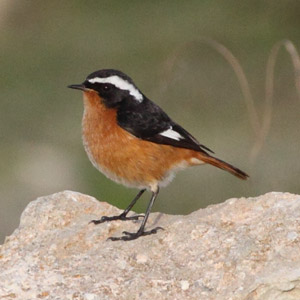Magazine | Analyses
Les mystérieuses observations de Rubiettes de Moussier dans le sud de l’Europe

Rubiette de Moussier (Phoenicurus moussieri) mâle sur l’île de Malte.Photographie : Michael Sammut
Introduction
Le Rougequeue ou Rubiette de Moussier (Phoenicurus moussieri) est un petit passereau endémique du nord-ouest de l’Afrique, vivant dans les milieux rocheux depuis le niveau de la mer jusqu’à 3 000 mètres d’altitude. Le mâle ne peut être confondu, tandis que la femelle ressemble à celle du Rougequeue à front blanc (Phoenicurus phoenicurus).
C’est un oiseau sédentaire, mais des individus descendent vers les régions côtières en hiver. En outre, des dizaines de rubiettes ont déjà été observées dans plusieurs pays du sud et de l’ouest de l’Europe, à Malte, en Grèce, en Italie, en Espagne, au Portugal, et jusqu’en Grande-Bretagne. Certaines ont même hiverné sur place.
Au cours de ces dernières années, le nombre d’observations a nettement augmenté dans l’archipel de Malte : Natalino Fenech et Michael Sammut, qui ont publié une note sur le sujet dans le numéro 106 de la revue British Birds en janvier 2013, nous ont transmis des informations sur ce phénomène intéressant. Nous remercions aussi Raymond Galea pour ses photos et ses compléments.
Abstract
The Moussier’s Redstart (Phoenicurus moussieri) is an endemic breeder in northwestern Africa. It inhabits rocky areas, from sea level up to 3,000 meters. The male is unmistakable : it has a black head with a broad white stripe running above each eye and down the side of the neck. The upperparts are black apart a white wing patch, and the rich chestnut tail. The underparts are a rich orange-red. The female has a pale brown head and upperparts, and the underparts are a paler orange than the male, although generally redder than the underparts of the similar but larger female Common Redstart.
It is a resident in North Africa, with some post-breeding dispersal to coastal areas. Vagrants have occurred in several countries in southern and western Europe. In particular, sightings have increased in Malta in recent years, and most of them arrived in Autumn and overwintered.
Natalino Fenech and Michael Sammut, who have published a note about this phenomenon in the issue 106 of British Birds (January 2013), sent us some informations, thoughts and photos about these sightings.
Poursuivez la lecture de cet article, en vous abonnant dès maintenant !
Découvrez les Archives d’Ornithomedia.com
Pour seulement 10,00 €TTC/an (ou 6,00 € les 6 mois)
Profitez de plusieurs centaines d’articles en accès illimité et sans aucun engagement.
Compléments
Auteurs
- Natalino Fenech – E-mail : natalino.fenech@yahoo.com
- Michael Sammut – E-mail : sammutmichael@gmail.com
À lire aussi sur Ornithomedia.com
- L’influence de la météo sur l’observation des oiseaux
- Le Roselin githagine en Espagne : un grand gagnant du réchauffement ?
À lire sur la page Google+ d’Ornithomedia.com
Une Rubiette de Moussier et un Courvite isabelle en Andalousie en avril 2012
Ouvrages recommandés
- A Complete Guide to the Birds of Malta de Natalino Fenech
- Le guide Ornitho de L. Svensson et al
- La France à tire-d’aile : Comprendre et observer les migrations d’oiseaux de Philippe-J Dubois (Auteur), Elise Rousseau (Auteur), Allain Bougrain Dubourg (Préface)
- Migrations de Claude Feigné (Auteur), Pierre Petit (Auteur)
À lire sur le web
Le livre de Natalino Fenech « A Complete Guide to the Birds of Malta » a été reconnu par British Birds comme l’un des meilleurs livres sur l’ornithologie de l’année 2011
Source
Natalino Fenech et Michael Sammut (2013). Increased numbers of wintering Moussier’s Redstarts in Malta. British Birds 106. janvier. Pages 42–44




 1 commentaire
1 commentaire
1 commentaire(s) sur ce sujet
Participer à la discussion !Raymond Galea
Birkirkara
Posté le 22 janvier 2013
Hi, sorry to write in English but my French is very limited! I am an experienced birder/ringer and ornithologist from Malta and it is very presumptive to say that Moussier’s Redstarts might come from the north (the Balkans) without any scientific evidence (like bird ringing). My opinion is that these birds are blown north from their North African home by southerly winds . Most of the birds recorded in the Maltese Islands have been found on the western side of the Islands (facing North Africa) and also they were found during or after southerly winds . I personally have ringed two females together on the Island of Comino in late October 2011 (prob first birds to be ringed in Europe) during Southerly winds and also a male was found by a colleague of mine last November after very strong Southerly winds. The position of our Islands, very close to the North African coast is an ideal place for such disoriented birds to occur. Almost all accidental records from Europe come from countries/Islands in the Mediterranean sea, first land they find after crossing the sea! Some pictures I took of several Moussiers Redstarts in Malta in the last 5 years are on Ornithomedia page in Facebook.
regards
Raymond Galea
Malta